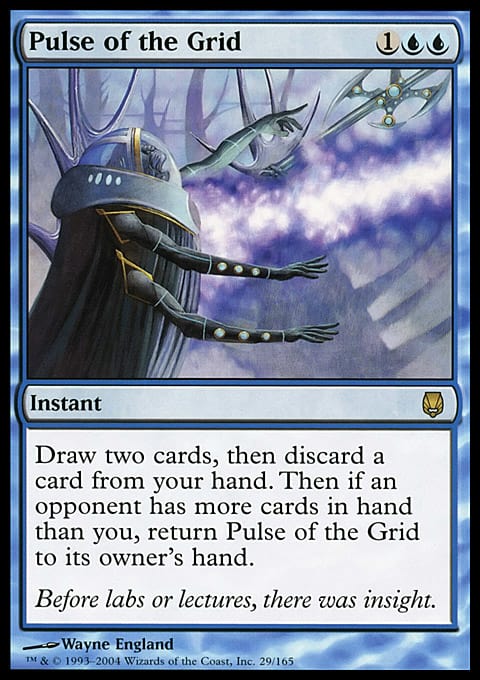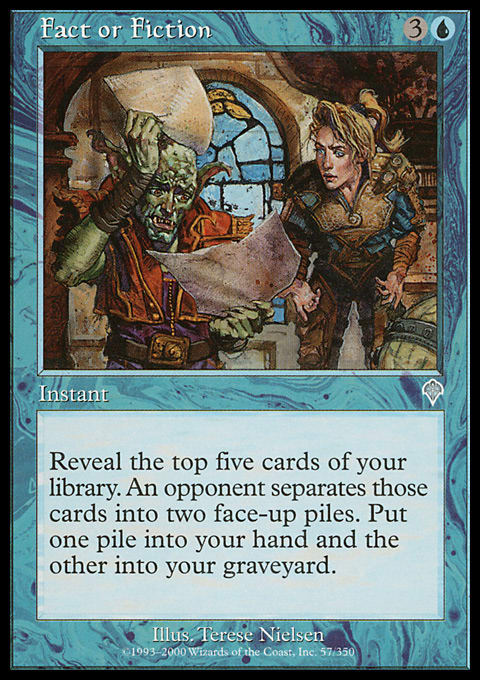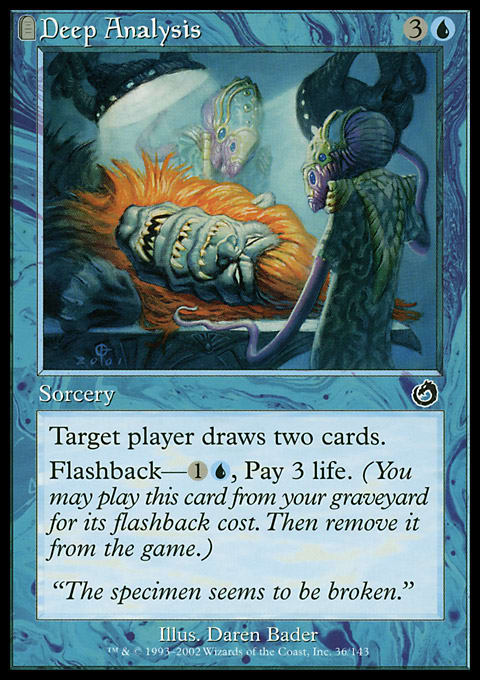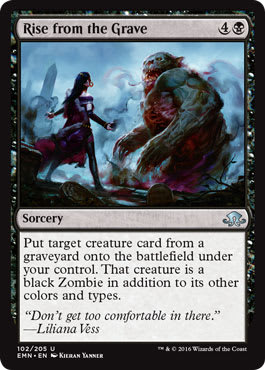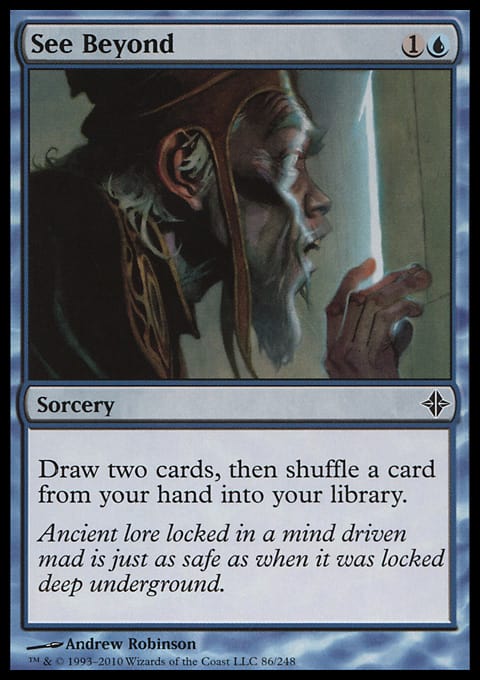One of the best ways to enjoy the Cube Draft format for all its worth is to become well acquainted with numerous types of Drafts. One of my favorites is Winchester Draft. In the comments section of my last article, a reader named IncrediSteve introduced me to a format I’d never heard of before: Grid Draft. So, I decided to call up a friend, draft my Cube a few times, and compare Grid to Winchester.
Before I jump into the comparison, let’s take a brief look at the two formats we’re discussing:
Grid Draft
- Create sixteen to eighteen packs with your Cube. Each pack contains nine cards.
- Lay out one pack in a three-by-three grid. All the cards are placed face-up.
- Player A picks a row or column of three cards. Then, Player B picks a row or column from what is left. The remaining cards are set aside. Those cards are no longer part of the Draft.
- Repeat with all the remaining packs, switching the first-pick choice back and forth between players.
- Build forty-card decks.

An example of a Grid Draft. Which set of three cards would you pick?
Winchester Draft
I first learned about this format via Tom LaPille’s article on DailyMTG.
- Create three packs for each player. Each pack contains fifteen cards.
- Each player lays out two cards from his or her first pack face-up. There are now four, one-card stacks.
- Player A picks a card. Each player then places a card from his or her pack on top of each of the two previous card stacks. One of the stacks will have only one card in it. All other stacks will have two cards.
- Player B drafts a stack of cards, taking all of the cards in that stack.
- Each player then adds a card from his or her pack on top of each stack, and player A drafts another stack.
- Repeat this process until all of the cards have been drafted in all three packs.
- Build forty-cards decks.

An example of a Winchester Draft after the first two picks. Which stack of cards would you choose?
Strengths and Weaknesses of Grid Draft
My thanks again to IncrediSteve for the introduction to Grid Draft. After some searching online, I also found this explanation on Cube-Draft.Blogspot.com.
Grid Draft has a lot of strengths:
- It’s fast – I estimate that it takes half the time of a typical Winchester Draft (and maybe even only a third of the time of a Winston Draft). It’s a great format if you’re anxious to get the Draft over with and start playing.
- Your best picks are easy to identify – If you pick first in this format, you have one of six choices with each pack. You can either choose Column 1, 2, or 3. Or, you can choose Row 1, 2, or 3. If you know what type of deck you’re drafting, it’s easy to identify what your first pick should be. When you are stuck with the second pick, it doesn’t take much to figure out what your best pick is with a little bit of If-he-picks-this-I’ll-pick-that type of planning.
- You get to see a lot of your Cube – The average Cube is over four hundred cards. However, this means if you just inserted a few cool new cards into your Cube, you may or may not even see them come up in a night of drafting, much less play them. With the Grid Draft format, you will see a hundred forty-four to a hundred sixty-two cards during each Draft (depending on whether you draft sixteen or eighteen packs). That’s a quarter or more of the average Cube. If you do two Drafts in one night, you’ll see over half your Cube come up. I love this. Sometimes, I enter a Cube night hoping for a chance to play a few of my favorites (say, Koth of the Hammer or Chalice of Life) only to spend a whole night drafting and not even see them. The chances of that happening in the Grid Draft format are greatly reduced.
- Grid is probably a better Draft format for new players – Because of how quickly you can identify what your first and second picks will be for each pack, I think a player who is new to the game will have an easier time learning how to draft with this format over more complex Draft structures such as Winchester, Winston, or Solomon.
This format also has a couple of weaknesses, though:
- It’s hard to be subtle – Whether you’re drafting with a certain deck in mind or you’re trying to hose the other person, this Draft makes it difficult to keep your intentions secret. All of the cards are out on the table. Everyone sees every card you chose and every card you skipped. It doesn’t take much for your opponent to figure out what you’re up to.
- You may not want easy choices – I’ve found that part of the fun of drafting a Cube is that every choice is hard. After all, aren’t most Cubes chock-full of the very best cards Magic has to offer? Every single choice is supposed to be tough. But in the Grid Draft format, the best choices for your deck become pretty obvious pretty quickly.
Strengths and Weaknesses of Winchester Draft
Like Grid Draft, this format has a few strengths:
- It’s fairly quick – Though it takes a few minutes longer than a Grid Draft, Winchester can easily be done in twenty minutes, which is a lot less time than most other formats.
- Winchester allows for a few tough, but fun decisions – When we do Winchester Drafts in my playgroup, I find that my defensive picks are often mixed with cards I’ll actually use in my deck because this format allows you to pick up a whole stack of cards. Some will fit your strategy, and some would fit your opponents’ strategy. As Tom LaPille says in his article, “All the decisions feel important.”
- It’s easier to be subtle about what you’re drafting (especially when you don’t have the first pick) – In a Grid Draft, every player can see the choices of each other player. If you have the first pick, you know exactly which cards you’ll be leaving behind for your opponent. This leaves your opponent with few options and makes it harder for him or her to hide what he or she is drafting. In Winchester Draft, because a card is added to each stack after your pick, it’s much harder to know what you’re leaving on the table for your opponent. It’s then easier for your opponent to grab a mixed stack of cards, leaving you foggy about what type of deck he or she is trying to build.
This format has a couple of weaknesses, too:
- You end up with more unusable cards in your final card pool – When you do a Grid Draft, you will end up with approximately forty cards, and around thirty of them will be able to go into your deck. During Winchester Drafts, your card pool will vary in size, and you’re more likely to end up with a greater number of off-color or off-strategy cards. When Winchester Drafts go badly, I find myself either forcing an extra color that really doesn’t fit, playing needless artifacts because I’m out of cards that fit my colors, or running extra land cards. That never happens in a Grid Draft. In a Grid Draft, I have to cut cards because I have too many good ones for a forty card deck.
- It’s possible to end up with a different deck than the one you set out to draft – Because you never know what cards will be added to each stack after your pick, there’s a greater chance that a card you need for your deck will be added to a stack your opponent grabs. For example, suppose you are drafting a Reanimator deck. However, after your last pick, you turned over Rise from the Grave and had to put it on a stack that already contained Mulch. Suppose your opponent picks that stack. There goes your Rise from the Grave and your Mulch, two great cards for a Reanimator deck. When the Draft is all said and done, you might end up playing a different strategy.
Thoughts to Chew on Before Your Next Draft
After playing and comparing these two formats a number of times, the first thing I’ve realized is: There’s value in picking the Draft format based on your opponent.
If you’re playing with an opponent that knows the game inside and out, you may want to stick with Winchester or something even harder. You’ll have a better shot at hosing the player, and you’re more likely to give him or her a Draft challenge the player will appreciate.
Contrariwise, if you’re playing with someone who is fairly new to the game, stick with Grid Draft. You will be able to explain things such as archetypes, Draft strategies, and other nuances more easily. It should also be more fun for the player because he or she will be more confident in his or her picks.
The second takeaway is: Decide what you want to know about your Cube, and pick your Draft format accordingly.
If you just added twenty or more cards to your Cube, I highly suggest going with Grid Draft a few times. Most of them will appear during the Draft, and you’ll quickly see which deck archetypes are supported (or not) within your Cube. You’re also more likely to see if your Cube is out of balance in any way (i.e. having too many cards of a certain color, too little of a certain color grouping, too many or too little of certain mana costs, etc.). Winchester Draft will reveal this information, too, but much more slowly.
The last lesson this comparison has taught me is one I think I knew intuitively because it’s woven into the very fabric of the game: Magic is more fun when you keep mixing things up.
It had been a while since my playgroup had tried something new. When we started playing the Grid Draft format, I could feel the excitement around the table. This was something fresh, and it was great fun!
What’s Your Next Draft Going to Be?
I hope you enjoyed this little comparison between Winchester and Grid Drafts. I think it’s good for Cube Draft players to think through the pros and cons of formats like this so we can ensure we’re creating the most enjoyable Draft experiences possible with whoever is sitting around the table with us.
Thanks again to IncrediSteve for telling me about Grid Draft. I also owe a debt of thanks to my good friend Brad who helped me develop these pros and cons over a few different Draft nights.
















